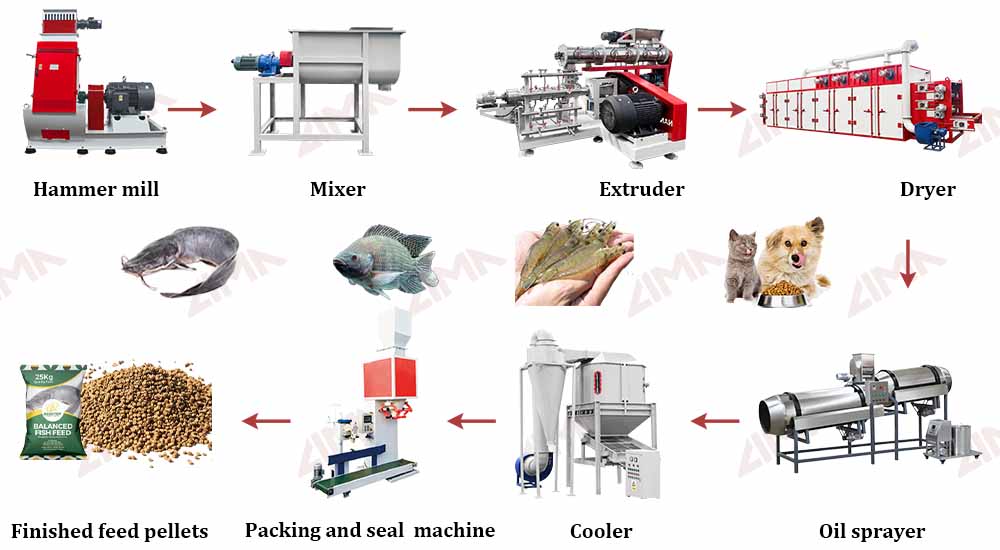Our fish feed pellet production line is the complete procedure of feed pellet production with a capacity of 1-2ton/h. This line is designed for making commercial pellets from corn, maize, soybean meal, fish meal, rice bran, bone powder, and so on, and final pellets with different shapes, unique flavors, rich nutrients, and fine textures, are widely used as aquatic feed and pet food like catfish, tilapia, shrimps, crabs, dog, cat, etc. Super automation control, and high production efficiency, our fish feed production line is the best choice for medium and large feed mills and fish farms. Complete pellet production lines with different capacities are also available to meet customers’ specific demands.
 |
 |
|
|
Raw material Crushing → Raw material Mixing → Extruding Process → Pellest Drying → Oil Spraying Process→ Pellets Cooling → Pellets Packing
Crushing process can reduce raw material size to desired particle size.
For even larger aquatic feed manufacturing factory, the crushing process adopts secondary crushing technology, that is first normal crushing, and then fine crushing.
Mixing is one of the most important processes in aquatic feed production plant. If the physical properties of feed ingredients are the same, mixing is very simple. But as a matter of fact, the physical properties of feed ingredients are varied, and the problem of mixing and separation coexist. These physical properties include: particle size, particle shape, density or specific gravity, hygroscopicity, static charge and viscosity.
When adding material to the feed mixer, the smaller the ingredient is, the later it should be added., such as vitamins, minerals and drug premixture. Before adding oil or liquid, all dry ingredients must be mixed well (dry mixed). After dry mixing, spray oil or other liquids on the top, then mix again (wet mix). Horizontal twin screw mixer is the most commonly used mixer for aquatic feed. Usually there is a discharge port equal to the full length of the mixer at the bottom. Most fish feeds need to add some liquids. In some cases, they need to add some moist raw materials. In practice, it is generally allowed to add 10% of the liquid.
To manufacture fish feed pellets, there are two main types of fish feed processing machines that can be used: dry type fish feed extruders and wet type fish feed extruders. Both dry type and wet type fish feed extruders are suitable for building a complete fish feed pellet production plant. Since the prices of these two extruders differ, the cost of establishing a fish feed pellet plant also varies! For more technical information, please feel free to contact us, and we will be happy to meet your needs at any time!
To prevent fish feed from becoming moldy, aquatic feed must have good preservative properties. For fish feed plants, the most economical method is to reduce the moisture content of the feed, and the way to do this is by using a dryer. A three-layer dryer can increase drying space and efficiency while simultaneously screening the fish feed pellets and separating the powder. After heating and drying, the moisture content of the product is controlled below 11.5%. Coupled with well-sealed outer packaging, the feed can generally be stored safely for a long time. This physical preservation method does not alter the composition of the feed, does not change the pH value of the feed, and does not affect the water quality or feed quality, making it a safe and effective method.
In the production of aquatic feed such as fish feed, the spraying of edible oil and heat-sensitive components is usually carried out using a drum sprayer. As the feed pellets fall, the misty liquid is sprayed onto them, allowing the feed pellets to fully contact the liquid droplets in the air. The main technical points of this external spraying technique are: (1) Atomize the liquid as much as possible; the smaller the atomized droplets, the more evenly the liquid is distributed within the pellets. To achieve this, the design of the spray nozzle is crucial. (2) Match the weight of the pellets with the liquid. The external spraying process is a continuous operation, and the water solubility of the spray liquid must be considered to avoid the liquid from being lost into the water.
After the fish feed pellets are sprayed with liquid, they are conveyed to a counter-flow cooler. The counter-flow cooler in fish feed pellet processing has advantages such as a high degree of automation, small air volume, low power consumption, and a small footprint.

If you want to make fish feed pellets but are unsure which machine to choose, please feel free to contact us. Lima Feed Machinery will provide you with the most professional fish feed processing guidance!